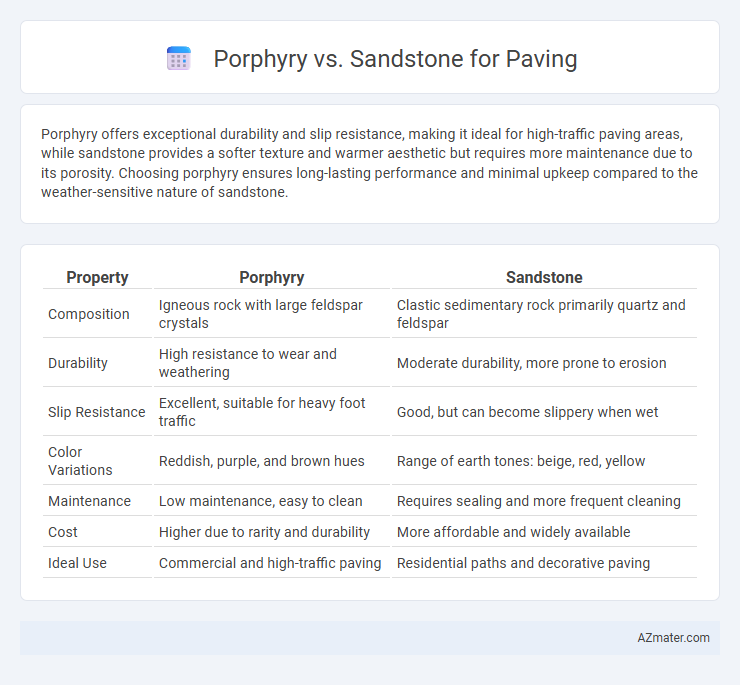Porphyry offers exceptional durability and slip resistance, making it ideal for high-traffic paving areas, while sandstone provides a softer texture and warmer aesthetic but requires more maintenance due to its porosity. Choosing porphyry ensures long-lasting performance and minimal upkeep compared to the weather-sensitive nature of sandstone.
Table of Comparison
| Property | Porphyry | Sandstone |
|---|---|---|
| Composition | Igneous rock with large feldspar crystals | Clastic sedimentary rock primarily quartz and feldspar |
| Durability | High resistance to wear and weathering | Moderate durability, more prone to erosion |
| Slip Resistance | Excellent, suitable for heavy foot traffic | Good, but can become slippery when wet |
| Color Variations | Reddish, purple, and brown hues | Range of earth tones: beige, red, yellow |
| Maintenance | Low maintenance, easy to clean | Requires sealing and more frequent cleaning |
| Cost | Higher due to rarity and durability | More affordable and widely available |
| Ideal Use | Commercial and high-traffic paving | Residential paths and decorative paving |
Introduction to Porphyry and Sandstone Paving
Porphyry paving offers exceptional durability and natural hardness, making it ideal for high-traffic outdoor areas due to its volcanic igneous rock composition. Sandstone paving, derived from sedimentary rock, provides a softer, more textured surface with varied color tones, lending a warm and natural aesthetic suitable for decorative landscaping. Both materials deliver unique advantages in strength, weather resistance, and visual appeal, influencing their selection for different paving applications.
Material Composition and Geological Origin
Porphyry is an igneous rock characterized by large, visible crystals of feldspar or quartz embedded in a fine-grained matrix, formed from slow cooling magma beneath the Earth's surface. Sandstone consists of compacted and cemented sand-sized mineral particles, primarily quartz, derived from sedimentary processes in ancient riverbeds or deserts. The durable and dense texture of porphyry offers superior wear resistance, while sandstone's sedimentary origin provides a softer, more porous surface ideal for aesthetic paving applications.
Aesthetic Appeal and Color Variations
Porphyry offers a rich, volcanic texture with deep reds, purples, and browns that create a dramatic and elegant aesthetic, contrasting sharply with the more muted, earthy tones of sandstone which range from soft beiges to warm ochres. The natural mineral composition of porphyry gives it a unique, speckled appearance that ages beautifully, while sandstone's layered structure provides a softer, more natural look with subtle color gradations. Both materials provide diverse color palettes for paving, but porphyry's vibrant and durable surface makes it a standout choice for bold, modern designs.
Durability and Weather Resistance
Porphyry offers exceptional durability due to its high density and hardness, making it highly resistant to wear and heavy traffic, while sandstone, being softer and more porous, is more prone to erosion and surface wear over time. Porphyry's low water absorption rate enhances its weather resistance, preventing frost damage and reducing the risk of cracking in cold climates, whereas sandstone tends to absorb moisture, which can lead to deterioration under freeze-thaw cycles. These properties make porphyry the preferred choice for paving in areas subject to harsh weather and heavy use, while sandstone is better suited for decorative or low-traffic applications.
Slip Resistance and Surface Texture
Porphyry offers superior slip resistance due to its naturally rough and uneven surface texture, making it ideal for wet or high-traffic areas. Sandstone features a softer, more porous texture that can become slippery when wet, requiring additional treatments or sealants to improve grip. The durability and hardness of porphyry contribute to its long-lasting texture, whereas sandstone may wear down faster, impacting its slip resistance over time.
Installation Process and Techniques
Porphyry offers a more complex installation process than sandstone due to its hardness and irregular shape, requiring specialized cutting tools and precise fitting techniques to ensure a stable surface. Sandstone's softer texture allows for easier cutting and shaping, facilitating quicker installation with traditional masonry tools and straightforward laying patterns. Both materials demand careful substrate preparation and appropriate jointing methods to prevent shifting and maintain durability in paving applications.
Maintenance Requirements and Longevity
Porphyry offers superior durability and low maintenance requirements due to its dense, hard composition that resists weathering and wear, making it ideal for high-traffic paving. Sandstone, while aesthetically appealing and easier to cut, typically requires more frequent sealing and upkeep to prevent surface erosion and staining. Porphyry's longevity surpasses sandstone, often lasting decades with minimal intervention, whereas sandstone may need periodic repairs and maintenance to maintain structural integrity and appearance.
Cost Comparison and Budget Considerations
Porphyry paving typically comes at a higher initial cost compared to sandstone due to its durability and distinctive aesthetic appeal, often priced between $15 to $30 per square foot, whereas sandstone averages $10 to $20 per square foot. Budget considerations must include long-term maintenance, with porphyry requiring less frequent repairs and offering greater resistance to weathering, potentially lowering lifetime expenses. Sandstone may present a more affordable upfront investment but can incur higher costs over time due to its softer nature and susceptibility to erosion.
Environmental Impact and Sustainability
Porphyry offers a more sustainable paving option due to its natural durability and low maintenance requirements, reducing the need for frequent replacements and associated resource consumption. Sandstone, while visually appealing, tends to erode faster and requires chemical treatments, which can contribute to environmental pollution. Choosing porphyry supports eco-friendly construction by minimizing carbon footprint and preserving natural resources through its longevity and resilience.
Best Applications and Design Ideas
Porphyry offers exceptional durability and a natural reddish-purple hue, making it ideal for high-traffic urban pavements and elegant courtyards requiring a timeless, sophisticated look. Sandstone provides versatile color variations from warm creams to deep reds, perfect for garden pathways, patios, and rustic-style driveways that emphasize natural, earthy aesthetics. Combining Porphyry's hardness with Sandstone's textural warmth results in visually striking designs suited to both contemporary and traditional outdoor spaces.

Infographic: Porphyry vs Sandstone for Paving
 azmater.com
azmater.com